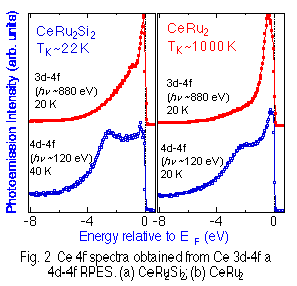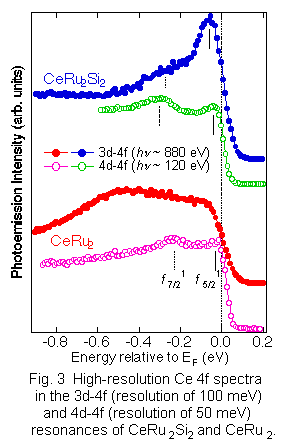High-resolution Ce 3d-4f resonance photoemission study
of heavy fermion and valence-fluctuating Ce compounds: Probing
bulk 4f electronic states for the first time
(Collaborating with Dr. Y. Saitoh in
SPring-8 and Prof. Y. Onuki in Osaka University)
Nature vol.403, p.396
(2000).
Here we show the power of
the technique "High-energy
and high-resolution photoemission spectroscopy", which has become a reality very recently
at BL25SU on SPring-8, by applying it to the Ce compounds CeRu2Si2
and CeRu2. Previous photoemission studies of these
compounds by using low-energy hν (~120
eV) revealed mutually similar spectra for the Ce 4f electronic
states, yet it is expected that such states should be different
owing to their differing degrees of hybridization with other
valence bands. Our determination
of the bulk Ce 4f electronic states of these compounds resolves
these differences.
Introduction
 Valence-band photoemission
spectroscopy (PES) is a useful technique
to investigate the hybridization and correlation of electronic
states. Since the Ce 4f contributions are remarkably enhanced
by using resonance PES (RPES), many Ce 4d-4f RPES (hν~120 eV) spectra
have so far been measured with high-resolution. However, a serious drawback of the PES
at low-hν (~120 eV) for the studies of the bulk
states has been gradually recognized as that the 4d-4f RPES is
surface-sensitive due to the short mean free path of the photoelectron
as shown in Fig.1. Considering its larger
bulk sensitivity, the Ce 3d-4f RPES is a useful and promising
technique to examine the bulk Ce 4f states. However, the energy
resolution of all previous 3d-4f RPES is as poor as ~0.7 eV, which
is unsatisfactory to observe detailed 4f states near the Fermi
level (EF).
Valence-band photoemission
spectroscopy (PES) is a useful technique
to investigate the hybridization and correlation of electronic
states. Since the Ce 4f contributions are remarkably enhanced
by using resonance PES (RPES), many Ce 4d-4f RPES (hν~120 eV) spectra
have so far been measured with high-resolution. However, a serious drawback of the PES
at low-hν (~120 eV) for the studies of the bulk
states has been gradually recognized as that the 4d-4f RPES is
surface-sensitive due to the short mean free path of the photoelectron
as shown in Fig.1. Considering its larger
bulk sensitivity, the Ce 3d-4f RPES is a useful and promising
technique to examine the bulk Ce 4f states. However, the energy
resolution of all previous 3d-4f RPES is as poor as ~0.7 eV, which
is unsatisfactory to observe detailed 4f states near the Fermi
level (EF).
In order to realize a breakthrough for
studying the bulk electronic states with using PES, we have constructed
a high-resolution soft x-ray (hν = 500-1500
eV) PES system combined with a varied-line-spacing plane grating
(VLSPGM) monochromator on a twin-helical undulator beam line BL25SU
of SPring-8. Here we show the obtained bulk-sensitive high-resolution
Ce 3d-4f RPES spectra of CeRu2Si2 and CeRu2
(energy resolution of about 100 meV at hn~880 eV!). CeRu2Si2 is a typical heavy fermion
system with the Kondo temperature (TK) of about 20
K. This material is thought to be located at a boundary between
the localized and itinerant Ce 4f states. On the other hand, CeRu2
is a typical material of the strongly valence-fluctuating 4f systems
(namely, very strongly hybridized systems), where TK
is of the order of 1000 K. The high-resolution Ce 3d-4f RPES was
performed at BL25SU on SPring-8. The results were compared with
the high-resolution Ce 4d-4f RPES spectra measured at BL-3B of
the Photon Factory with the overall resolution of 50 meV.
Results and discussion
 Firstly we show the Ce 4f spectra
of CeRu2Si2 and CeRu2 over a
wide energy range. In the 3d-4f spectrum of CeRu2Si2,
there is a sharp peak near EF and a broad tail ranging
from -1 to -5 eV. According to the single impurity Anderson model
(SIAM), the former corresponds to the contribution of both the
tail of the Kondo peak (f5/21) and its spin-orbit partner
(f7/21). The latter is ascribed to the f0
final states; in the 4d-4f spectrum on the other hand, the f0
final states located at -2.5 eV is prominent, reflecting the localized
character of the surface 4f states. In the 3d-4f spectrum of CeRu2,
the f0 broad tail is greatly suppressed compared to
CeRu2Si2, indicating that the bulk Ce 4f
states are considerably hybridized. But the surface f0
state of CeRu2 is seen as a hump near -2 eV in the
4d-4f spectrum, as in CeRu2Si2. These
differences reveal that the 4d-4f spectra mainly reflect the surface
4f electronic states.
Firstly we show the Ce 4f spectra
of CeRu2Si2 and CeRu2 over a
wide energy range. In the 3d-4f spectrum of CeRu2Si2,
there is a sharp peak near EF and a broad tail ranging
from -1 to -5 eV. According to the single impurity Anderson model
(SIAM), the former corresponds to the contribution of both the
tail of the Kondo peak (f5/21) and its spin-orbit partner
(f7/21). The latter is ascribed to the f0
final states; in the 4d-4f spectrum on the other hand, the f0
final states located at -2.5 eV is prominent, reflecting the localized
character of the surface 4f states. In the 3d-4f spectrum of CeRu2,
the f0 broad tail is greatly suppressed compared to
CeRu2Si2, indicating that the bulk Ce 4f
states are considerably hybridized. But the surface f0
state of CeRu2 is seen as a hump near -2 eV in the
4d-4f spectrum, as in CeRu2Si2. These
differences reveal that the 4d-4f spectra mainly reflect the surface
4f electronic states.
 The detailed high-resolution
spectra near EF are shown in Fig. 3 for the 3d-4f and 4d-4f resonances. We note that the 4d-4f spectral line-shapes
of CeRu2Si2 and CeRu2 are qualitatively
similar, despite the TK values of these compounds differing
by orders of magnitude. There are two
comparable structures, located just below EF and near
-0.3 eV. However, the
3d-4f spectra of these compounds differ greatly. For CeRu2Si2, there is a prominent
peak in the vicinity of EF, and a weak shoulder near
-0.3 eV. These two structure originate from the bulk f5/21
and f7/21 final states. in other words,
from the tail of the Kondo peak and its spin-orbit partner, as
predicted from SIAM. The observation of such a strong tail of
the bulk Kondo peak has been made possible by the bulk-sensitive
3d-4f RPES technique with an unprecedentedly high resolution of
100 meV. The two peaks in the 4d-4f spectrum of CeRu2Si2
can also be assigned in the same manner, but to the surface f5/21
and f7/21 final states resulting from the
weaker hybridization effect in the surface.
The detailed high-resolution
spectra near EF are shown in Fig. 3 for the 3d-4f and 4d-4f resonances. We note that the 4d-4f spectral line-shapes
of CeRu2Si2 and CeRu2 are qualitatively
similar, despite the TK values of these compounds differing
by orders of magnitude. There are two
comparable structures, located just below EF and near
-0.3 eV. However, the
3d-4f spectra of these compounds differ greatly. For CeRu2Si2, there is a prominent
peak in the vicinity of EF, and a weak shoulder near
-0.3 eV. These two structure originate from the bulk f5/21
and f7/21 final states. in other words,
from the tail of the Kondo peak and its spin-orbit partner, as
predicted from SIAM. The observation of such a strong tail of
the bulk Kondo peak has been made possible by the bulk-sensitive
3d-4f RPES technique with an unprecedentedly high resolution of
100 meV. The two peaks in the 4d-4f spectrum of CeRu2Si2
can also be assigned in the same manner, but to the surface f5/21
and f7/21 final states resulting from the
weaker hybridization effect in the surface.
We
can also assign the two peaks in the 4d-4f spectrum of CeRu2
in Fig. 3 as the surface f5/21 and f7/21
final states. The 3d-4f
line-shape of CeRu2 is, however, rather surprising
as no structure is seen except for a broad feature centered at
-0.5 eV. One would have expected that
the tail of the Kondo peak should be much stronger in the bulk-sensitive
3d-4f spectrum for a very strongly hybridized system like CeRu2,
as predicted from SIAM. The experimental results that the 3d-4f
spectrum shows a rather conventional Fermi cut-off and a broad
peak at -0.5 eV cannot be deduced from SIAM. Therefore
we conclude that the bulk 4f spectral line-shape in CeRu2
represents itinerant "4f-band" character due to a very
strong hybridization effect, beyond the framework of SIAM. Such spectral
behavior, which has not been revealed
by previous 4d-4f RPES studies, reflects the real TK and bulk properties.
Finally we are convinced that
this new photoemission technique realizes a breakthrough for studies
of genuine bulk electronic states of many rare-earth and transition-metal
compounds.
- Akira Sekiyama




